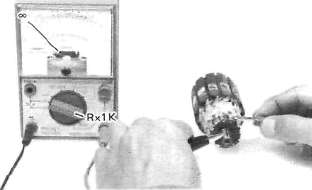ELECTRIC STARTING SYSTEM
B. Starter motor
1. Removal (see CHAPTER 3. "ENGINE DISASSEMBLY")
2. Inspection and repair
a. Check the outer surface of the commutator. If its surface is dirty, clean with# 600 grit sand paper.
b. The mica insulation between commutator segments should be 0.4 — 0.8 mm (0.02 "- 0.03 in) below the segment level. If not, scrape to proper limits with appropriately shaped tool. (A hack saw blade can be ground to fit.)
NOTE:
Mica insulation of commutator must be undercut to ensure proper operation of commutator.

c. The starter's armature coil should be check with an ohm meter for insulation break down (shorting to each other or to ground) and for continuity. Reference figure is given below.
Coil resistance:
Armature coil: 0.012H at 20°C (68°F
Continuity check

Insulation check

d. Check the front and rear cover bearings for damage. If damaged, the starter assembly must be replaced.
e. Check brush length. Replace brush if at, or near, limits.
Minimum brush length: 5.0 mm (0.20 ia

f. Check brush spring pressure. Compare it with a new spring. Replace the old spring if it is weak.
C. Starter relay switch 1. Inspection
a. Disconnect starter cable at the relay.
b. Connect pocket tester leads to the relay terminals (ohms x 1 scale).
c. Turn ignition to "ON" position, engine stop switch to "RUN" and change lever to "NEUTRAL".
d. Push the starter button. The relay should click once and the scale should read zero if it does not read zero, the relay must be replaced.

1. Baltery lead wire (+)
2. Starter motor lead wire
e. If the relay does not click, check the wires from the starter button and from the battery (red/white, blue/white). Turn the ignition off. Use (ohms x 1) scale on tester. The resistance between these wires should be no more than 3.5 ohms. If there is more resistance, the relay should be replaced.

E. Starting circuit cutoff switch
1. Open the seat and remove the fuel tank.
2. Connect pocket tester leads to the relay terminals (ohms x 1 scale).
3. Check the resistance between terminals. If resistance is out of specification, relay is broken. The relay must be replaced.
Unit: Ω
|
Pocket tester connecting point |
Black |
||||
|
(+) Red |
|
Blue |
# 1 Red/ While |
Black/ Yellow |
#2 Red/ White |
|
Blue |
|
160 ~240 |
8 ~ 12 |
∞ |
|
|
#1 Red/ White |
∞ |
|
∞ |
||
|
8lack/ Yellow |
∞ |
104 ~156 |
|
||
|
#2 Red/ White |
∞ |
oo |
∞ |
|
|
∞ : Discontinuity

- Printer-friendly version
- Log in to post comments

